Titus Groan is the first book of the Gormenghast trilogy (before Gormenghast and Titus Alone).
The castle of Gormenghast is a huge, maze-like fortress built on the side of a mountain. It's surrounded by a tall wall, that helps keep the noble "Castle" people and their menials inside, and the "Bright Carvers", a tribal people who live in mud dwellings, outside on the arid plain.
In this first volume, we're introduced to the castle's inhabitants, amidst the bustle of Titus the seventy-seventh Earl's birth, and a few days later, of his christening. There's the melancholic Lord Sepulchrave, the seventy-sixth and current Earl of Groan, his enormous wife Gertrude and her white cats, and their teenage daughter Fuchsia. And there is Mrs. Slagg, the frail old Nanny who's always complaning about her poor heart, and Mr. Flay, the Earl's tall first servant with the clicking knees. And also Mr. Rottcodd, curator of the Hall of Bright Carvings, and Sourdust the Librarian, guardian of the Protocol. Doctor Prunesquallor with his nervous laughter, and his spinsterly sister Irma, as well as Swelter the tyrannic cook and his kitchen boys, among which the young Steerpike. Then come Cora and Clarice, the Earl's asinine twin sisters, envious of his and Gertrude's power... and a few others.
As the story flows, we watch these numerous protagonists interact, as Steerpike slowly works his way up the ranks of the castle. Charming high-born ladies, plotting arson, nothing daunts him. And what was a so well-greased, fine-tuned machine of minutiae and protocol, the very essence of Gormenghast, is starting to crumble slowly and inexorably.
It's very hard to summarize Titus Groan in a couple of paragraphs. It's so brimming with court intrigue and mischief, interspaced with lush descriptions of this amazingly intricate fortress where I wanted to escape to, or play hide and seek in. As a whole, all I can say it that it was an enormous pleasure to read and that I can't wait to read the next book.
An enormous pleasure to read.
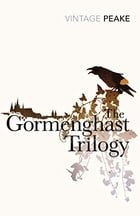 Posted : 19 years, 1 month ago on 21 May 2006 06:34
(A review of The Gormenghast Trilogy)
Posted : 19 years, 1 month ago on 21 May 2006 06:34
(A review of The Gormenghast Trilogy) 0 comments, Reply to this entry
0 comments, Reply to this entry
A rather exciting beginning for a syrupy
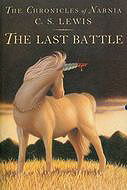 Posted : 19 years, 1 month ago on 21 May 2006 06:32
(A review of The Last Battle (The Chronicles of Narnia))
Posted : 19 years, 1 month ago on 21 May 2006 06:32
(A review of The Last Battle (The Chronicles of Narnia))This is the seventh and last (chronologically) Chronicle of Narnia (after The Magician's Nephew; The Lion, the Witch and the Wardrobe; The Horse and His Boy; Prince Caspian; The Voyage of the Dawn Treader; The Silver Chair).
This final volume is more or less cut in two parts. In the first one, an Ape called Shift bullies and forces his companion Puzzle the donkey to wear an old lion skin on his back and to pretend he's Aslan the great Lion. Allied with Calormenes, they start slaughtering Talking Beasts and doing other evil deeds.
To Tirian, the current King of Narnia, and to his dear friend Jewel the noble Unicorn, this seems like a most unusual behaviour for Aslan, so they set out in search of the truth. They'll call children from our world to their aid: Eustace and Jill.
Ensues a battle opposing the King's small party to the Calormenes and the Men and Beasts they've managed to cheat.
In the second half of the book, like a mirror of the adventures of Digory and Polly in The Magician's Nephew, we witness the unmaking of the World by Aslan (the real one this time). Like in a curtain call, all the characters (but one) from the previous volumes return for the final journey to the forever kingdom of Aslan.
Whereas the beginning was rather exciting, I found the ending really too syrupy and allegorical. It was also very shocking to see the absence of Susan explained by "she's interested in nothing nowadays except nylons and lipstick and invitations." With its oldish style, and the fact that the baddies, the Calormenes, have a definite Middle-Eastern profile, I felt that the book was really anchored in the 1950's. I must admit I'm glad to have finally finished the series.
This final volume is more or less cut in two parts. In the first one, an Ape called Shift bullies and forces his companion Puzzle the donkey to wear an old lion skin on his back and to pretend he's Aslan the great Lion. Allied with Calormenes, they start slaughtering Talking Beasts and doing other evil deeds.
To Tirian, the current King of Narnia, and to his dear friend Jewel the noble Unicorn, this seems like a most unusual behaviour for Aslan, so they set out in search of the truth. They'll call children from our world to their aid: Eustace and Jill.
Ensues a battle opposing the King's small party to the Calormenes and the Men and Beasts they've managed to cheat.
In the second half of the book, like a mirror of the adventures of Digory and Polly in The Magician's Nephew, we witness the unmaking of the World by Aslan (the real one this time). Like in a curtain call, all the characters (but one) from the previous volumes return for the final journey to the forever kingdom of Aslan.
Whereas the beginning was rather exciting, I found the ending really too syrupy and allegorical. It was also very shocking to see the absence of Susan explained by "she's interested in nothing nowadays except nylons and lipstick and invitations." With its oldish style, and the fact that the baddies, the Calormenes, have a definite Middle-Eastern profile, I felt that the book was really anchored in the 1950's. I must admit I'm glad to have finally finished the series.
 0 comments, Reply to this entry
0 comments, Reply to this entry
Rather predictable.
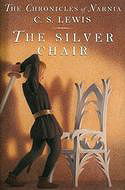 Posted : 19 years, 1 month ago on 21 May 2006 06:32
(A review of The Silver Chair (The Chronicles of Narnia))
Posted : 19 years, 1 month ago on 21 May 2006 06:32
(A review of The Silver Chair (The Chronicles of Narnia))This is the sixth (chronologically) Chronicle of Narnia (after The Magician's Nephew; The Lion, the Witch and the Wardrobe; The Horse and His Boy; Prince Caspian; The Voyage of the Dawn Treader, and before The Last Battle).
In this volume, Eustace Scrubb and his schoolmate Jill Pole are called to Narnia by the great lion. Aslan gives them a mission, and four signs to go by, to find King Caspian's lost son Prince Rilian, who's been missing for ten years.
With the help of a parliament of owls, and of Puddleglum the friendly but pessimistic Marsh-wiggle, they'll travel through Ettinsmoor to Harfang, the horrible city of Giants, and then to the Underland to confront the evil Witch-Queen.
The second half of the book was more entertaining than the beginning, which I found a tad slow until the children are on the way. Still, after six books the story becomes rather predictable, and not very passionating, although I enjoyed the passage with the Silver Chair. But I'm sure children would be enthralled by the hero's adventures.
In this volume, Eustace Scrubb and his schoolmate Jill Pole are called to Narnia by the great lion. Aslan gives them a mission, and four signs to go by, to find King Caspian's lost son Prince Rilian, who's been missing for ten years.
With the help of a parliament of owls, and of Puddleglum the friendly but pessimistic Marsh-wiggle, they'll travel through Ettinsmoor to Harfang, the horrible city of Giants, and then to the Underland to confront the evil Witch-Queen.
The second half of the book was more entertaining than the beginning, which I found a tad slow until the children are on the way. Still, after six books the story becomes rather predictable, and not very passionating, although I enjoyed the passage with the Silver Chair. But I'm sure children would be enthralled by the hero's adventures.
 0 comments, Reply to this entry
0 comments, Reply to this entry
Not much more to add.
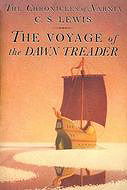 Posted : 19 years, 1 month ago on 21 May 2006 06:32
(A review of The Voyage of the Dawn Treader (The Chronicles of Narnia))
Posted : 19 years, 1 month ago on 21 May 2006 06:32
(A review of The Voyage of the Dawn Treader (The Chronicles of Narnia))This is the fifth (chronologically) Chronicle of Narnia (after The Magician's Nephew; The Lion, the Witch and the Wardrobe; The Horse and His Boy; Prince Caspian, and before The Silver Chair; The Last Battle).
This book takes Edmund and Lucy Pevensie, along with their annoying bully of a cousin Eustace, once again to the land of Narnia, more precisely on the Great Eastern Ocean, on Prince Caspian's ship, the Dawn Treader.
Caspian and Reepicheep the valiant talking mouse, are indeed on a quest to the Lone Islands, where they hope to find the seven lords Caspian's tyrannic uncle Miraz sent into exile.
On this trip, the children will meet dragons and merpeople, as well as strange one-legged creatures called the Dufflepuds. Lucy will again be very brave, and Eustace will learn to become a better person. Together they wil travel to the End of the World, in search of Aslan's country.
I'm sorry I don't have many more comments to add since the previous volumes. I liked this book, but I can't say whether it's better than the others or not. I just wasn't captivated by the story, except maybe in a chapter or two. The overly talkative Reepicheep tended to get on my nerves, and although the passage with the boat treading the sea of lilies was quite enchanting, the ending was too allegorical for me. Gosh am I getting too old?
This book takes Edmund and Lucy Pevensie, along with their annoying bully of a cousin Eustace, once again to the land of Narnia, more precisely on the Great Eastern Ocean, on Prince Caspian's ship, the Dawn Treader.
Caspian and Reepicheep the valiant talking mouse, are indeed on a quest to the Lone Islands, where they hope to find the seven lords Caspian's tyrannic uncle Miraz sent into exile.
On this trip, the children will meet dragons and merpeople, as well as strange one-legged creatures called the Dufflepuds. Lucy will again be very brave, and Eustace will learn to become a better person. Together they wil travel to the End of the World, in search of Aslan's country.
I'm sorry I don't have many more comments to add since the previous volumes. I liked this book, but I can't say whether it's better than the others or not. I just wasn't captivated by the story, except maybe in a chapter or two. The overly talkative Reepicheep tended to get on my nerves, and although the passage with the boat treading the sea of lilies was quite enchanting, the ending was too allegorical for me. Gosh am I getting too old?
 0 comments, Reply to this entry
0 comments, Reply to this entry
Frustrated.
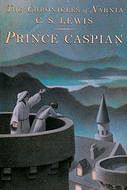 Posted : 19 years, 1 month ago on 21 May 2006 06:31
(A review of Prince Caspian: The Return to Narnia (The Chronicles of Narnia))
Posted : 19 years, 1 month ago on 21 May 2006 06:31
(A review of Prince Caspian: The Return to Narnia (The Chronicles of Narnia))This is the fourth (chronologically) Chronicle of Narnia (after The Magician's Nephew; The Lion, the Witch and the Wardrobe; The Horse and His Boy, and before The Voyage of the Dawn Treader; The Silver Chair; The Last Battle).
In this volume we meet again with the four heroes from The Lion, the Witch and the Wardrobe: Peter, Susan, Edmund and Lucy. A year after coming back to England, they're waiting on the station platform for the trains that will take them back to boarding school after the summer holidays, when suddenly, they're transported into another world.
It is soon apparent that they've landed on an island. Driven by hunger, and not knowing when they might go back to their world, they start exploring the place. All they can find is apples from trees that have overgrown an ancient castle ruin. But as they explore these old stones, they realize they're none other than those of Cair Paravel, the palace where they used to dwell when they were Kings and Queens of Narnia. Why is it in such a poorly state?
Later, they will save a Dwarf who will tell them how and why they were summoned back to Narnia, and help the young prince Caspian escape from his tyrannic uncle Miraz, the usurper of the throne.
This booked started out well. I was excited at the prospect of exploring the old ruins of Cair Paravel, looking for treasures hidden under centuries of vines and ivy. But then the story's tone changed, and it became very similar to the previous volumes. I'm not against consistency, but I was beginning to build magical images of haunted castles and suddenly they all collapsed and faded, and I felt a little frustrated.
In this volume we meet again with the four heroes from The Lion, the Witch and the Wardrobe: Peter, Susan, Edmund and Lucy. A year after coming back to England, they're waiting on the station platform for the trains that will take them back to boarding school after the summer holidays, when suddenly, they're transported into another world.
It is soon apparent that they've landed on an island. Driven by hunger, and not knowing when they might go back to their world, they start exploring the place. All they can find is apples from trees that have overgrown an ancient castle ruin. But as they explore these old stones, they realize they're none other than those of Cair Paravel, the palace where they used to dwell when they were Kings and Queens of Narnia. Why is it in such a poorly state?
Later, they will save a Dwarf who will tell them how and why they were summoned back to Narnia, and help the young prince Caspian escape from his tyrannic uncle Miraz, the usurper of the throne.
This booked started out well. I was excited at the prospect of exploring the old ruins of Cair Paravel, looking for treasures hidden under centuries of vines and ivy. But then the story's tone changed, and it became very similar to the previous volumes. I'm not against consistency, but I was beginning to build magical images of haunted castles and suddenly they all collapsed and faded, and I felt a little frustrated.
 0 comments, Reply to this entry
0 comments, Reply to this entry
So-so...
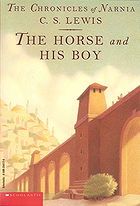 Posted : 19 years, 1 month ago on 21 May 2006 06:31
(A review of The Horse and His Boy (The Chronicles of Narnia, Book 5))
Posted : 19 years, 1 month ago on 21 May 2006 06:31
(A review of The Horse and His Boy (The Chronicles of Narnia, Book 5))This is the third volume (chronologically) in The Chronicles of Narnia (after The Magician's Nephew; The Lion, the Witch and the Wardrobe, and before Prince Caspian; The Voyage of the Dawn Treader; The Silver Chair; The Last Battle).
In this book we meet Shasta, a young boy who's been raised by Arsheesh, a poor fisherman far south in Calormen. One day comes a stranger on a strong warhorse, although it soon appears that this is a tyrannic Tarkaan who wants to buy Shasta and make him a slave. But his horse is actually Bree (does that name ring a bell?), a talking horse from Narnia, who come night, decides to gallop home to freedom, taking Shasta along.
While on the run across the desert, they meet a girl named Aravis and her talking mare Hwin, who's also fleeing, but from her future marriage with Ahoshta Tarkaan the vizier.
Their first stop will be the city of Tashbaan, where Shasta is mistaken for Corin, King Lune of Archenand's son. There he'll also make the acquaintance, among others, of Queen Susan, whom we met in The Lion, the Witch and the Wardrobe, and learn that she's also about to marry Rabadash, the mighty Tisroc of Calormen's son, but doesn't want to.
Later, Shasta will become a hero by warning King Lune of an imminent attack by both disappointed bridegrooms.
My opinion on this book is so-so. Again, I think Avaris and Shasta's tumultuous adventure is something that can really appeal to a younger audience but, this makes me feel sorry, I personally just failed to get into it. Mark you, I still think I'm going to read the Chronicles of Narnia to my kids when I have some... I'm sure they'll enjoy them.
In this book we meet Shasta, a young boy who's been raised by Arsheesh, a poor fisherman far south in Calormen. One day comes a stranger on a strong warhorse, although it soon appears that this is a tyrannic Tarkaan who wants to buy Shasta and make him a slave. But his horse is actually Bree (does that name ring a bell?), a talking horse from Narnia, who come night, decides to gallop home to freedom, taking Shasta along.
While on the run across the desert, they meet a girl named Aravis and her talking mare Hwin, who's also fleeing, but from her future marriage with Ahoshta Tarkaan the vizier.
Their first stop will be the city of Tashbaan, where Shasta is mistaken for Corin, King Lune of Archenand's son. There he'll also make the acquaintance, among others, of Queen Susan, whom we met in The Lion, the Witch and the Wardrobe, and learn that she's also about to marry Rabadash, the mighty Tisroc of Calormen's son, but doesn't want to.
Later, Shasta will become a hero by warning King Lune of an imminent attack by both disappointed bridegrooms.
My opinion on this book is so-so. Again, I think Avaris and Shasta's tumultuous adventure is something that can really appeal to a younger audience but, this makes me feel sorry, I personally just failed to get into it. Mark you, I still think I'm going to read the Chronicles of Narnia to my kids when I have some... I'm sure they'll enjoy them.
 0 comments, Reply to this entry
0 comments, Reply to this entry
Duller than expected...
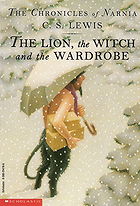 Posted : 19 years, 1 month ago on 21 May 2006 06:30
(A review of The Lion, the Witch and the Wardrobe (The Chronicles of Narnia, Book 1))
Posted : 19 years, 1 month ago on 21 May 2006 06:30
(A review of The Lion, the Witch and the Wardrobe (The Chronicles of Narnia, Book 1))...unless you start with this tome?
This is the second volume (chronologically) in The Chronicles of Narnia (after The Magician's Nephew, before The Horse and His Boy; Prince Caspian; The Voyage of the Dawn Treader; The Silver Chair; The Last Battle).
This book takes place during World War II, many years after the events of The Magician's Nephew, and tells the story of four young siblings, Peter, Susan, Edmund and Lucy. They are exploring the big house of an old Professor (which I'm guessig is Digory from the first book) where they've been sent during the air-raids, when Lucy enters the old wardrobe in en empty room upstairs to hide in it.
Only this wardrobe is actually a direct passage to the world of Narnia, and Lucy finds herself in a forest on a snowy night, the only light that of a lamppost. There she meets a Faun named Tumnus, who is indeed very amazed to meet a legendary Human, an invites her to tea. In the cozy warmth of his home, he tells her of the evil White Witch, who is turning everyone who opposes her to stone, and whose spell on Narnia makes it always winter and never Christmas.
When Lucy finally gets out of the wood and then out of the wardrobe again, no time has actually passed, and of course, when she tells her story to her brothers and sister, none of them believes her. Edmund in particular likes to make fun of her.
On another, rainy day, when they're all playing hide-and-seek in the huge mansion, Edmund decides to hide in the wardrobe and he too finds himself in Narnia. But instead of the Faun, he meets the White Witch, who lures him with Turkish Delight (his favourite sweets) and by making him believe that he can become King if he brings her his brother and sisters.
The book then tells the adventures of the four kids in Narnia, meeting a friendly couple of talking badgers and all kinds of other fantastic animals and creatures, among then the powerful Lion King Aslan, and helping them save the world from the evil usurper Queen.
Reading the series in the chronological order rather than in the publication order, I found that The Magician's Nephew was actually a kind of spoiler for The Lion, the Witch and the Wardrobe. I think that I would have been more enchanted, amazed and curious about the world of Narnia if I hadn't read all about its creation in the first book. I would have wondered about the lamppost, for example (and it would have been nice to read about the Lion's song later). Knowing about it in advance, I'm sure I found it a tad duller, because I wasn't discovering it at the same time as the kids. This is a nice story, and I know it's a Classic, but I must say it's not as captivating as I thought it would be.
I advise you read it in the publication order: The Lion, the Witch and the Wardrobe; Prince Caspian; The Voyage of the Dawn Treader; The Silver Chair; The Horse and His Boy; The Magicians Nephew; The Last Battle.
This is the second volume (chronologically) in The Chronicles of Narnia (after The Magician's Nephew, before The Horse and His Boy; Prince Caspian; The Voyage of the Dawn Treader; The Silver Chair; The Last Battle).
This book takes place during World War II, many years after the events of The Magician's Nephew, and tells the story of four young siblings, Peter, Susan, Edmund and Lucy. They are exploring the big house of an old Professor (which I'm guessig is Digory from the first book) where they've been sent during the air-raids, when Lucy enters the old wardrobe in en empty room upstairs to hide in it.
Only this wardrobe is actually a direct passage to the world of Narnia, and Lucy finds herself in a forest on a snowy night, the only light that of a lamppost. There she meets a Faun named Tumnus, who is indeed very amazed to meet a legendary Human, an invites her to tea. In the cozy warmth of his home, he tells her of the evil White Witch, who is turning everyone who opposes her to stone, and whose spell on Narnia makes it always winter and never Christmas.
When Lucy finally gets out of the wood and then out of the wardrobe again, no time has actually passed, and of course, when she tells her story to her brothers and sister, none of them believes her. Edmund in particular likes to make fun of her.
On another, rainy day, when they're all playing hide-and-seek in the huge mansion, Edmund decides to hide in the wardrobe and he too finds himself in Narnia. But instead of the Faun, he meets the White Witch, who lures him with Turkish Delight (his favourite sweets) and by making him believe that he can become King if he brings her his brother and sisters.
The book then tells the adventures of the four kids in Narnia, meeting a friendly couple of talking badgers and all kinds of other fantastic animals and creatures, among then the powerful Lion King Aslan, and helping them save the world from the evil usurper Queen.
Reading the series in the chronological order rather than in the publication order, I found that The Magician's Nephew was actually a kind of spoiler for The Lion, the Witch and the Wardrobe. I think that I would have been more enchanted, amazed and curious about the world of Narnia if I hadn't read all about its creation in the first book. I would have wondered about the lamppost, for example (and it would have been nice to read about the Lion's song later). Knowing about it in advance, I'm sure I found it a tad duller, because I wasn't discovering it at the same time as the kids. This is a nice story, and I know it's a Classic, but I must say it's not as captivating as I thought it would be.
I advise you read it in the publication order: The Lion, the Witch and the Wardrobe; Prince Caspian; The Voyage of the Dawn Treader; The Silver Chair; The Horse and His Boy; The Magicians Nephew; The Last Battle.
 0 comments, Reply to this entry
0 comments, Reply to this entry
Enjoyed it with ups and downs.
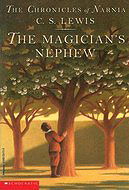 Posted : 19 years, 1 month ago on 21 May 2006 06:29
(A review of The Magician's Nephew (The Chronicles of Narnia))
Posted : 19 years, 1 month ago on 21 May 2006 06:29
(A review of The Magician's Nephew (The Chronicles of Narnia))This is the first book in the Chronicles of Narnia heptalogy (before The Lion, the Witch and the Wardrobe; The Horse and His Boy; Prince Caspian; The Voyage of the Dawn Treader; The Silver Chair; The Last Battle).
This volume tells a story which takes place in London in the second half of the nineteenth century. It starts with a boy and a girl, Digory and Polly, who stumble into Digory's Uncle Andrew's attic while they were exploring the "secret passage" in the space between the walls and the roofs, in their row of houses.
Uncle Andrew is a magician of sorts, and when he tells Polly to touch one of the yellow rings he made, she suddenly vanishes. In his turn, but taking care to put two pairs of both yellow and green rings into his jacket's pockets, Digory touches the yellow ring and follows Polly. They both emerge in a mysteriously quiet forest, scattered with little ponds inamongst the trees. It won't take them long to understand the mechanism of this Wood Between the Worlds.
Indeed, using the correct ring and jumping into one of the ponds, they are transported to Charn, where Digory incidentally awakes the stunningly beautiful witch Jadis, a 7-foot-tall queen whose unquenchable thirst for power made her murder her own people. Now, like a cat who, having toyed too long with the mouse it caught, has finally killed it and discards it, she hankers for new worlds to conquer. She forces Digory and Polly to take her to London to meet Uncle Andrew, who she believes is a powerful magician who will help her in her conquest.
Of course when she realizes he's not, she wreaks havoc in the city, and finally has an accident when the hansom she's riding hits a lamppost. In the confusion of the ensuing fight, and before she unleashes her terrible wrath, Digory manages to snatch her heel. With Polly holding on to him, he puts the yellow ring on to bring Jadis back to Charn. But as it turns out, several others were connected, including a cabby and his horse and Uncle Andrew, and they all end up in the Wood Between the Worlds. Jumping into another pond, which turns out to be the wrong one, everyone is transported to an utterly dark place instead, where they soon hear the first notes of a beautiful song and watch the sky become lighter little by little.
This enchanting voice belongs in fact to the lion Aslan, and what our heroes are witnessing is the creation of the world of Narnia from the lion's song, the birth of the animals and the growing of the plants.
I enjoyed this books with ups and downs. Whereas I really loved the atmosphere of the Wood Between the Worlds and the dazzling chapter of the creation of Narnia, I wasn't much captivated by the events around the evil queen Jadis or Uncle Andrew. I think we can conclude with certainty, but this was to be expected, that I prefer the fantasy or fairy-tale parts to those that connect to the real world. I'm trying very hard to avoid spotting anything allegorical, which tends to break the charm for me. I'm also usually rather annoyed when the author addresses the reader, but it only happened from time to time, so that didn't bother me too much. But I must say was surprised to discover that even though the story continues in the following books, that of Digory and Polly was over in this one. I wonder what lies in store...
This volume tells a story which takes place in London in the second half of the nineteenth century. It starts with a boy and a girl, Digory and Polly, who stumble into Digory's Uncle Andrew's attic while they were exploring the "secret passage" in the space between the walls and the roofs, in their row of houses.
Uncle Andrew is a magician of sorts, and when he tells Polly to touch one of the yellow rings he made, she suddenly vanishes. In his turn, but taking care to put two pairs of both yellow and green rings into his jacket's pockets, Digory touches the yellow ring and follows Polly. They both emerge in a mysteriously quiet forest, scattered with little ponds inamongst the trees. It won't take them long to understand the mechanism of this Wood Between the Worlds.
Indeed, using the correct ring and jumping into one of the ponds, they are transported to Charn, where Digory incidentally awakes the stunningly beautiful witch Jadis, a 7-foot-tall queen whose unquenchable thirst for power made her murder her own people. Now, like a cat who, having toyed too long with the mouse it caught, has finally killed it and discards it, she hankers for new worlds to conquer. She forces Digory and Polly to take her to London to meet Uncle Andrew, who she believes is a powerful magician who will help her in her conquest.
Of course when she realizes he's not, she wreaks havoc in the city, and finally has an accident when the hansom she's riding hits a lamppost. In the confusion of the ensuing fight, and before she unleashes her terrible wrath, Digory manages to snatch her heel. With Polly holding on to him, he puts the yellow ring on to bring Jadis back to Charn. But as it turns out, several others were connected, including a cabby and his horse and Uncle Andrew, and they all end up in the Wood Between the Worlds. Jumping into another pond, which turns out to be the wrong one, everyone is transported to an utterly dark place instead, where they soon hear the first notes of a beautiful song and watch the sky become lighter little by little.
This enchanting voice belongs in fact to the lion Aslan, and what our heroes are witnessing is the creation of the world of Narnia from the lion's song, the birth of the animals and the growing of the plants.
I enjoyed this books with ups and downs. Whereas I really loved the atmosphere of the Wood Between the Worlds and the dazzling chapter of the creation of Narnia, I wasn't much captivated by the events around the evil queen Jadis or Uncle Andrew. I think we can conclude with certainty, but this was to be expected, that I prefer the fantasy or fairy-tale parts to those that connect to the real world. I'm trying very hard to avoid spotting anything allegorical, which tends to break the charm for me. I'm also usually rather annoyed when the author addresses the reader, but it only happened from time to time, so that didn't bother me too much. But I must say was surprised to discover that even though the story continues in the following books, that of Digory and Polly was over in this one. I wonder what lies in store...
 0 comments, Reply to this entry
0 comments, Reply to this entry
Not convinced.
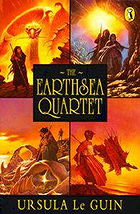 Posted : 19 years, 1 month ago on 21 May 2006 06:28
(A review of The Earthsea Quartet: "A Wizard Of Earthsea"; "The Tombs of Atuan"; "The Farthest Shore"; "Tehanu" (Puffin Books))
Posted : 19 years, 1 month ago on 21 May 2006 06:28
(A review of The Earthsea Quartet: "A Wizard Of Earthsea"; "The Tombs of Atuan"; "The Farthest Shore"; "Tehanu" (Puffin Books))A Wizard of Earthsea: Not convinced yet.
This is the first volume in the Earthsea quartet (followed by The Tombs of Atuan, The Farthest Shore and Tehanu).
After his mother's death, young Ged gets to live with his father, a smith, and his aunt the village witch, who teaches him some minor spells, such as commanding to animals, until one day he uses this magic to save the village from barbaric invaders.
Impressed by the boy's potential powers, the mage Ogion takes him as apprentice. But as the days go by, Ged becomes bored and when the choice is offered him, he decides to go to the wizards school of Roke. There he meets with two other scholars: Vetch who'll soon become his friend, and the arrogant Jasper who always looks down on him, and who'll become his rival.
And after several months spent in the school, with hatred steadily growing between them, Ged one day challenges Jasper in a magic duel. And as Ged, in a surge of immoderate pride, is trying to wake the dead, he accidentally unleashes an evil shadow, also almost managing to get himself killed in the process. The story goes on to describe Ged perpetual flight from his shadow.
Ursula LeGuin's style is elaborate and poetic, but maybe a little bit too much, too old-fashioned, for my liking. As a result, the novel somehow failed to fascinate me, and in the end I realized I didn't care much about what happened to the characters. I'll read the rest of the quartet anyway, in hope it gets more gripping.
The Tombs of Atuan: Unexpectedly gripping.
This is the second volume in the Earthsea quartet (following A Wizard of Earthsea and followed by The Farthest Shore and Tehanu).
The story takes place on the desert island of Atuan. There, in a terrifying ritual, a five-year-old little girl becomes Arha, the Eaten One. As the years go by in the Place of the Tombs, among an odd community of young scholar girls, old women and eunuchs, she learns the sacred dances and songs devoted to the Nameless Ones.
At the age of fourteen, she finally becomes the One Priestess, the guardian of the Great Treasure, and the only one to know the ways of the Labyrinth, a place of utter darkness where men are not allowed and cruelly put to death if found there.
The story was beginning to bore me, I was watching Arha becoming more arrogant, and old Kossil meaner, by the day and I was reluctantly facing the fact that I didn't care much for her... until the middle of the book, until Arha one day comes across a dim light in the pitch black of the Labyrinth. And as it brings a complete upheaval in Arha's well-ordered and dull life, with it the story also becomes enthralling and finally I almost couldn't put the book down. I hope The Farthest Shore won't disappoint me...
The Farthest Shore: A nice story, but not very enthralling.
This is the third volume in the Earthsea quartet (following A Wizard of Earthsea and The Tombs of Atuan, and followed by Tehanu).
The Farthest Shore, set some fifteen or twenty years after the events of The Tombs of Atuan, tells the story of Ged, now an Archmage, and Arren, a young prince, and their voyage around the world of Earthsea in search of the Unmaker, who is responsible for the disappearence of magic and of the balance of the world.
Compared to The Tombs of Atuan, I found this third part rather disapointing and lacking in action. Ged and Arren are just travelling from one island to the next, and nothing really happens. The evolution of their friendship is interesting, though, and that's what kept me reading. But as a whole, I found the series rather boring, although well written if you like old-fashioned style, and will only read Tehanu for the sake of it.
Tehanu: The best book in the series.
This is the fourth and final volume in the Earthsea quartet (following A Wizard of Earthsea, The Tombs of Atuan and The Farthest Shore).
In this book, Ursula K. LeGuin goes back to Tenar, now a middle-aged farm woman, to tell us the story of her life after the events of The Tombs of Atuan. Only recently a widow, she decides to take the child Therru under her wing, a little girl who has been cruelly raped and terrifyingly burnt and maimed by her parents who, fearing her, wanted to get rid of her.
The story goes on to describe their life on the farm on the island of Gont, Therru growing up, and their perpetual flight from the child's family who want to "finish the job".
Tehanu was written some fifteen years after the original Earthsea trilogy, and the evolution in Ursula K. LeGuin's style, as well as the maturation of the whole Earthsea world are quite noticeable.
This is a stunning conclusion to the series, that got me hooked right from the beginning. And what a pleasure to meet again with all the main characters of Earthsea!
This is the first volume in the Earthsea quartet (followed by The Tombs of Atuan, The Farthest Shore and Tehanu).
After his mother's death, young Ged gets to live with his father, a smith, and his aunt the village witch, who teaches him some minor spells, such as commanding to animals, until one day he uses this magic to save the village from barbaric invaders.
Impressed by the boy's potential powers, the mage Ogion takes him as apprentice. But as the days go by, Ged becomes bored and when the choice is offered him, he decides to go to the wizards school of Roke. There he meets with two other scholars: Vetch who'll soon become his friend, and the arrogant Jasper who always looks down on him, and who'll become his rival.
And after several months spent in the school, with hatred steadily growing between them, Ged one day challenges Jasper in a magic duel. And as Ged, in a surge of immoderate pride, is trying to wake the dead, he accidentally unleashes an evil shadow, also almost managing to get himself killed in the process. The story goes on to describe Ged perpetual flight from his shadow.
Ursula LeGuin's style is elaborate and poetic, but maybe a little bit too much, too old-fashioned, for my liking. As a result, the novel somehow failed to fascinate me, and in the end I realized I didn't care much about what happened to the characters. I'll read the rest of the quartet anyway, in hope it gets more gripping.
The Tombs of Atuan: Unexpectedly gripping.
This is the second volume in the Earthsea quartet (following A Wizard of Earthsea and followed by The Farthest Shore and Tehanu).
The story takes place on the desert island of Atuan. There, in a terrifying ritual, a five-year-old little girl becomes Arha, the Eaten One. As the years go by in the Place of the Tombs, among an odd community of young scholar girls, old women and eunuchs, she learns the sacred dances and songs devoted to the Nameless Ones.
At the age of fourteen, she finally becomes the One Priestess, the guardian of the Great Treasure, and the only one to know the ways of the Labyrinth, a place of utter darkness where men are not allowed and cruelly put to death if found there.
The story was beginning to bore me, I was watching Arha becoming more arrogant, and old Kossil meaner, by the day and I was reluctantly facing the fact that I didn't care much for her... until the middle of the book, until Arha one day comes across a dim light in the pitch black of the Labyrinth. And as it brings a complete upheaval in Arha's well-ordered and dull life, with it the story also becomes enthralling and finally I almost couldn't put the book down. I hope The Farthest Shore won't disappoint me...
The Farthest Shore: A nice story, but not very enthralling.
This is the third volume in the Earthsea quartet (following A Wizard of Earthsea and The Tombs of Atuan, and followed by Tehanu).
The Farthest Shore, set some fifteen or twenty years after the events of The Tombs of Atuan, tells the story of Ged, now an Archmage, and Arren, a young prince, and their voyage around the world of Earthsea in search of the Unmaker, who is responsible for the disappearence of magic and of the balance of the world.
Compared to The Tombs of Atuan, I found this third part rather disapointing and lacking in action. Ged and Arren are just travelling from one island to the next, and nothing really happens. The evolution of their friendship is interesting, though, and that's what kept me reading. But as a whole, I found the series rather boring, although well written if you like old-fashioned style, and will only read Tehanu for the sake of it.
Tehanu: The best book in the series.
This is the fourth and final volume in the Earthsea quartet (following A Wizard of Earthsea, The Tombs of Atuan and The Farthest Shore).
In this book, Ursula K. LeGuin goes back to Tenar, now a middle-aged farm woman, to tell us the story of her life after the events of The Tombs of Atuan. Only recently a widow, she decides to take the child Therru under her wing, a little girl who has been cruelly raped and terrifyingly burnt and maimed by her parents who, fearing her, wanted to get rid of her.
The story goes on to describe their life on the farm on the island of Gont, Therru growing up, and their perpetual flight from the child's family who want to "finish the job".
Tehanu was written some fifteen years after the original Earthsea trilogy, and the evolution in Ursula K. LeGuin's style, as well as the maturation of the whole Earthsea world are quite noticeable.
This is a stunning conclusion to the series, that got me hooked right from the beginning. And what a pleasure to meet again with all the main characters of Earthsea!
 0 comments, Reply to this entry
0 comments, Reply to this entry
Coming full circle.
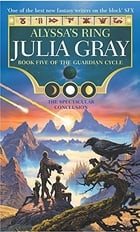 Posted : 19 years, 1 month ago on 21 May 2006 06:23
(A review of Alyssa's Ring (Guardian Cycle))
Posted : 19 years, 1 month ago on 21 May 2006 06:23
(A review of Alyssa's Ring (Guardian Cycle))This is the fifth and final book of The Guardian Cycle (after The Dark Moon, The Jasper Forest, The Crystal Desert, and The Red Glacier).
More years have passed since the events of The Red Glacier, and after failing to heal the insane Elemental on Myvatan, it's now time for Terrel to cross the Movaghassi Ocean once more and make his way home, to Vadanis.
Terrel is now travelling in the land of Kenda with a ragtag group of men: Faulk, an imposing but taciturn former mercenary, Lawren, who believes he's a seer, Nomar the healer and his son Taryn, who can see in other people's dreams, and Roskin, a falconer. On the way, they also meet two runaways, a young lady called Yllen and Pieri the storyteller.
Stopping for the night at the Haven Inn, it isn't long before they pick up rumours among the local gossip that the city of Vergos is in turmoil. That same night, Terrel learns that there are Sleepers in Vergos, and that the next lunar conjunction, prophesied as the end of the World, is scheduled for less than three months later. He has to go there before it's too late. Alas, it is soon apparent that the elements are against him, as huge balls of fire start to fall from the sky and spurts of molten lava start to gush form the surrounding volcanos.
The book goes on to describe Terrel and his companion's struggle to avert disaster and find a way to finally get back to the Floating Islands before the next conjuction to fulfill the promise he and Alyssa made eachother so many years ago.
Again, I enjoyed this book a lot, but more because of the interaction between its characters than for the way the overall plot is solved. Indeed, Mark & Julia Smith (Julia Gray) once more introduced interesting and loveable protagonists, whom I liked spending time with, whereas the conclusion left me somewhat unmoved. But don't they say that the journey is more important that the destination?
More years have passed since the events of The Red Glacier, and after failing to heal the insane Elemental on Myvatan, it's now time for Terrel to cross the Movaghassi Ocean once more and make his way home, to Vadanis.
Terrel is now travelling in the land of Kenda with a ragtag group of men: Faulk, an imposing but taciturn former mercenary, Lawren, who believes he's a seer, Nomar the healer and his son Taryn, who can see in other people's dreams, and Roskin, a falconer. On the way, they also meet two runaways, a young lady called Yllen and Pieri the storyteller.
Stopping for the night at the Haven Inn, it isn't long before they pick up rumours among the local gossip that the city of Vergos is in turmoil. That same night, Terrel learns that there are Sleepers in Vergos, and that the next lunar conjunction, prophesied as the end of the World, is scheduled for less than three months later. He has to go there before it's too late. Alas, it is soon apparent that the elements are against him, as huge balls of fire start to fall from the sky and spurts of molten lava start to gush form the surrounding volcanos.
The book goes on to describe Terrel and his companion's struggle to avert disaster and find a way to finally get back to the Floating Islands before the next conjuction to fulfill the promise he and Alyssa made eachother so many years ago.
Again, I enjoyed this book a lot, but more because of the interaction between its characters than for the way the overall plot is solved. Indeed, Mark & Julia Smith (Julia Gray) once more introduced interesting and loveable protagonists, whom I liked spending time with, whereas the conclusion left me somewhat unmoved. But don't they say that the journey is more important that the destination?
 0 comments, Reply to this entry
0 comments, Reply to this entry
 Login
Login
 Home
Home 7 Lists
7 Lists 198 Reviews
198 Reviews Collections
Collections